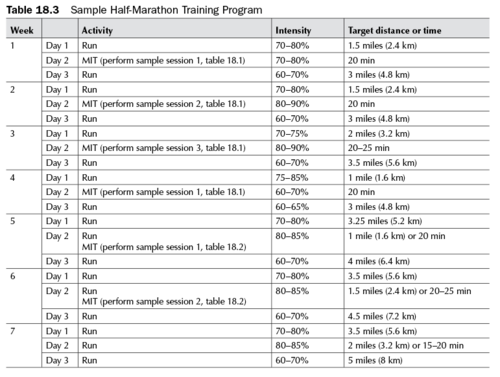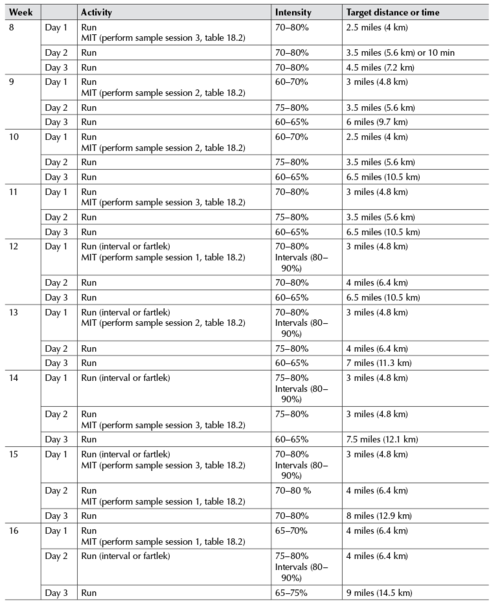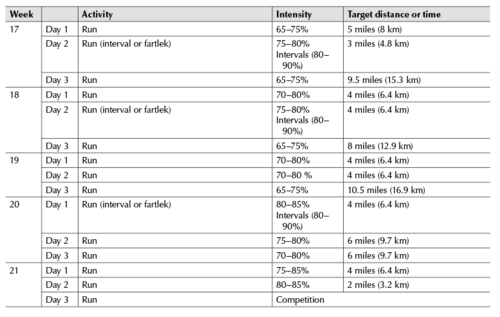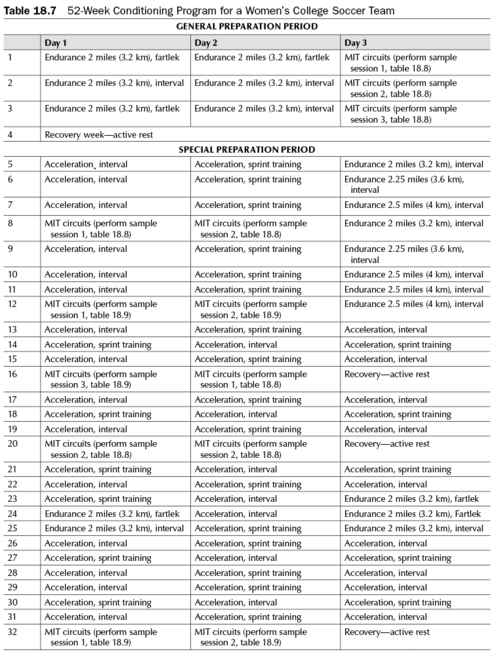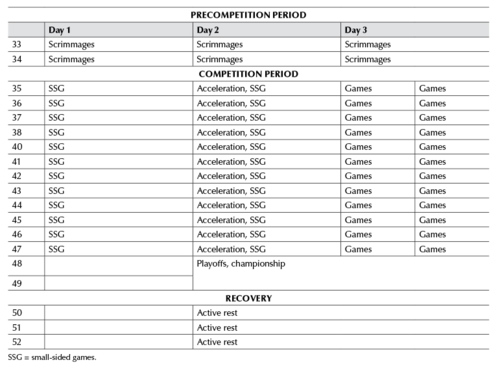How Endurance Is Trained
Aerobic endurance is critical for sports that require athletes to sustain an activity for a long duration, such as triathlons, marathons, cycling contests, and various types of adventure races. The main goal of these types of events, other than enjoyment, is to cover the given distance in the shortest time possible. Because of the distances that must be covered, participants must work at low intensity to persist. Otherwise, fatigue significantly hinders performance.
Aerobic power is generally measured by determining maximal oxygen uptake, or  O2 max. After a person reaches a certain level, however, improvements in
O2 max. After a person reaches a certain level, however, improvements in  O2max become more marginal. In fact, the ability to maintain activity at a high percentage of
O2max become more marginal. In fact, the ability to maintain activity at a high percentage of  O2max may be a better predictor of performance than aerobic capacity alone. Specifically, people who can maintain exercise at
a higher percentage of their
O2max may be a better predictor of performance than aerobic capacity alone. Specifically, people who can maintain exercise at
a higher percentage of their  O2max without accumulating a large amount of lactic acid have a distinct advantage over their competitors. To improve this ability,
people must train at or near their maximal lactate steady state, or the exercise intensity at which maximal lactate production
is equal to maximal lactate clearance. This training can be done by using some of the methods that we will discuss in this
section. In addition to
O2max without accumulating a large amount of lactic acid have a distinct advantage over their competitors. To improve this ability,
people must train at or near their maximal lactate steady state, or the exercise intensity at which maximal lactate production
is equal to maximal lactate clearance. This training can be done by using some of the methods that we will discuss in this
section. In addition to  O2max, movement economy is a critical factor for endurance performance. People who have better technique and form waste less
energy during training and events. Similar to the novice weight lifter, a person who begins and then regularly performs a
specific type of endurance activity becomes more efficient at the movements required to execute the task.
O2max, movement economy is a critical factor for endurance performance. People who have better technique and form waste less
energy during training and events. Similar to the novice weight lifter, a person who begins and then regularly performs a
specific type of endurance activity becomes more efficient at the movements required to execute the task.
For instance, when testing for  O2max, runners would likely achieve a higher score using an assessment that emphasizes running. Conversely, if asked to perform
a maximal aerobic test on an indoor rowing machine, runners would likely struggle to reach their true aerobic capacity because
they would probably waste a lot of energy trying to gain proficiency in executing a foreign movement. Instead, they would
achieve their
O2max, runners would likely achieve a higher score using an assessment that emphasizes running. Conversely, if asked to perform
a maximal aerobic test on an indoor rowing machine, runners would likely struggle to reach their true aerobic capacity because
they would probably waste a lot of energy trying to gain proficiency in executing a foreign movement. Instead, they would
achieve their  O2peak, which is simply the highest
O2peak, which is simply the highest  O2 that they are able to achieve on a given test. This further explains why sport specificity is important for reaching peak
performance. In essence, a person who has a goal of participating in a specific endurance event such as a half marathon (13.1
miles, or 21 km) would need to run at a distance and intensity similar to the event on a consistent basis. Furthermore, other
forms of endurance and resistance training and maximal interval training may be effectively used to complement aerobic endurance
performance. But performing resistance training or maximal interval training (MIT) alone and expecting to run a full marathon
would likely produce a poor performance.
O2 that they are able to achieve on a given test. This further explains why sport specificity is important for reaching peak
performance. In essence, a person who has a goal of participating in a specific endurance event such as a half marathon (13.1
miles, or 21 km) would need to run at a distance and intensity similar to the event on a consistent basis. Furthermore, other
forms of endurance and resistance training and maximal interval training may be effectively used to complement aerobic endurance
performance. But performing resistance training or maximal interval training (MIT) alone and expecting to run a full marathon
would likely produce a poor performance.
Conversely, when seeking to improve anaerobic endurance for intermittent sports, the focus of training tends to favor developing speed endurance, at or above the lactate threshold, rather than steady-state endurance. This is generally done by performing repeated short (3- to 10-second) sprints with brief recovery (10 to 60 seconds) between bouts (Bishop, Girard, and Mendez-Villanueva 2011; Dawson 2012; Girard, Mendez-Villanueva, and Bishop 2011). This form of training is aimed at improving the athlete’s ability to sustain her or his average maximal speed over a match or improve average peak power and work capacity over the duration of a game. In addition to repeat sprint ability (RSA) training, the use of conditioning games is popular among coaches and athletes. The aim of these games is to help athletes play their way into shape by using activities that are contextually appropriate to game scenarios.
Repeat sprint ability becomes critically important during the latter stages of a match or competition. As fatigue sets in over the course of the game, a player’s physical ability diminishes. RSA training can help improve the ability to sustain and reproduce maximal speed efforts and recover more quickly between sprints. Fatigue may also hinder the movement mechanics necessary to execute skill-related tasks because fatigued muscles do not produce force as effectively. Additionally, a player’s perceptual skills, decision-making ability, and focus tend to diminish as fatigue takes hold.
Variables
Given the demands of endurance training, creating a careful balance among training variables is essential. In general, as the intensity and duration of the activity increase, the amount of rest required increases. Highly trained athletes require less rest to recover between training bouts than those who are less trained. In general, two to five endurance-training sessions per week are adequate for most people. More than five training sessions per week may increase the risk of repetitive injuries, so the decision to add more training sessions should be evaluated based on the needs of the person and adjusted with caution. Obviously, as the number of training sessions increases, the intensity of those sessions should decrease, and vice versa. Generally, those who are engaged in more speed endurance training versus aerobic endurance training would perform fewer sessions to allow adequate recovery between high-intensity work bouts.
Intensity, or how hard an athlete is working, is quantified and monitored in many endurance endeavors by using the target heart method (THR) and by estimating or tracking heart rate during training. To calculate THR, we must first determine the theoretical maximum heart rate (MHR). This number can be easily found by subtracting the age of the athlete from 220. For instance, a 30-year-old athlete has a theoretical maximum heart rate of approximately 190 beats per minute (bpm). If this athlete wants to train at 80 to 85 percent of his or her estimated maximal heart rate, he or she would perform the following equation:
Target heart rate at 80 percent of estimated maximal heart rate of 190 beats per minute
THR = 190 × .80
THR = 152 bpm
Target heart rate at 85 percent of estimated maximal heart rate of 190 beats per minute
THR = 190 × .85
THR = 161.5 bpm
Setting a heart rate range for training is useful because the athlete can then push a bit harder at times and back off slightly at other times during a session while still remaining in the target range. Heart rate during activity can be monitored by taking a 10-second pulse at the carotid or radial artery and multiplying the count by 6 to get the estimated beats per minute. For example, if the 10-second pulse is 27, we would solve the following simple equation:
10-second heart rate = 27 beats per minute
60 sec HR= 27 × 6
60 sec HR = 162 bpm
This number would coincide with a heart rate just above 85 percent of the MHR in the previous example.
Many athletes prefer to streamline the process of tracking their intensity through the use of heart rate monitors. These monitors provide the user with an instantaneous reading of HR, making it easy to maintain the desired intensity throughout the duration of the activity. A more crude, but effective, method for determining exercise intensity is to rate the perceived exertion level during a training bout on a scale of 1 to 10, with 1 being not difficult at all and 10 being extremely difficult. For example, a rating of 8 would reflect an intensity of about 80 percent of the athlete’s perceived maximal effort. Although this method is a bit less precise, it helps athletes gauge training intensity and may be more practical in settings in which monitoring equipment cannot be used or it is difficult for the player to stop to get a pulse, such as when performing conditioning games.
Globally speaking, duration and intensity for endurance activities are inversely related, meaning that the longer the training session is, the lower the intensity must be to sustain the activity. For example, exercise performed at between 85 and 93 percent of target heart rate generally coincides with an intensity at or near the maximal lactate steady state. Subsequently, when exercise is performed at this intensity, the work bouts will be relatively short; after 20 to 30 minutes, the accumulation of lactic acid will make it increasingly difficult for the athlete to continue. Exercise performed at lower intensity (70 to 75 percent) can be sustained for longer periods, often up to several hours, depending on the person’s fitness.
The intensity selected depends largely on the particular energy system we wish to develop. Lower intensity, below 85 percent of THR, tends to favor aerobic endurance adaptations, whereas submaximal intensity between 85 and 93 percent begins to challenge the glycolytic energy system to a greater extent and helps improve the ability to sustain exercise at a higher training threshold.
Tools
A variety of methods can be used to improve endurance performance. Many of these methods focus on using intensity at or near
the maximal lactate steady state to improve the ability to work at a higher percentage of the  O2max. For many team sports, however, the ability to repeat short bursts of explosive, high-intensity sprints may be more critical
than being able to sustain steady-state activity for a long time. This section explains several techniques for improving endurance
in both areas.
O2max. For many team sports, however, the ability to repeat short bursts of explosive, high-intensity sprints may be more critical
than being able to sustain steady-state activity for a long time. This section explains several techniques for improving endurance
in both areas.
Long, Slow Distance Training
Long, slow distance (LSD) training is used primarily to improve aerobic capacity. This form of training is performed at low to moderate intensity (between approximately 70 and 85 percent of THR) for a long duration (greater than 30 minutes). Although the term long, slow distance may be a bit of a misnomer because the person is still usually trying to cover the distance in a relatively short time, the name emphasizes the relationship between intensity and duration. To sustain activity for a longer period, a lower intensity must be employed. Training modalities generally use the larger muscle groups of the legs and hips and are performed using repetitive movements for greater than 15 to 20 minutes at submaximal intensity (70 to 85 percent). Some options include running outdoors or on a treadmill; using a step trainer, elliptical trainer, or rower; lap swimming; spinning; and road or mountain biking. As previously discussed, however, you should select the most sport-specific activity for the bulk of your training and do another form of aerobic training periodically as a method of reducing repetitive motion stress on the body. That approach helps reduce the risk of injury or overtraining.
For improving speed endurance or RSA, short bouts of high-intensity (90 to 100 percent) effort over relatively short periods (less than 10 seconds) with a rest of 10 to 60 seconds between repetitions and a rest of 2 to 3 minutes between sets should be used. Although the majority of training should focus on activities similar to the sport (usually running), other methods of training such as games that use a blend of high, low, and moderate intensity can also be used when performing team conditioning. These games are excellent for disguising work as play and for providing a break from traditional training methods aimed at performing specific distances, times, and work-to-rest ratios.
Interval Training
Interval training consists of performing short or moderately long work bouts at a relatively high intensity interspersed with
periods of reduced intensity or complete rest within a single training session. This method of training is often used to improve
speed endurance and  O2max and to enhance aerobic metabolism by improving the ability to buffer lactic acid build-up. Long work intervals can be
performed for approximately 2 to 3 minutes at an intensity of around 80 to 90 percent of maximal effort or for shorter work
bouts (15 seconds to 2 minutes) at 85 to 100 percent of maximal effort.
O2max and to enhance aerobic metabolism by improving the ability to buffer lactic acid build-up. Long work intervals can be
performed for approximately 2 to 3 minutes at an intensity of around 80 to 90 percent of maximal effort or for shorter work
bouts (15 seconds to 2 minutes) at 85 to 100 percent of maximal effort.
As the intensity and duration of the interval increase, so does the time needed for the person to recover from the bouts. Generally, for longer intervals performed at 80 to 90 percent of maximal effort, a 1:0.5 to 1:2 work-to-rest ratio is used. For shorter work bouts performed at 85 to 100 percent effort, a 1:2 to 1:5 work-to-rest ratio should be allowed. This form of training can be performed on one or two days per week.
Fartlek Training
Fartlek is a Swedish word that means “speed play.” This type of training combines random higher-intensity intervals with continuous training based on how the person feels during a training session. Fartlek training does not rely on the use of specific durations or intensities; instead, the athlete varies the intensity over the course of the training session. If the person feels as if she or he can go at a higher intensity, the person simply adjusts the speed or cadence to a faster pace. When the person feels that she or he can no longer sustain the pace, the person simply reduces the intensity to recover. This unstructured form of interval training can be especially useful for beginners because it allows them the freedom to adjust the training session based on their current level of fitness. In addition, it reduces the boredom and monotony often associated with LSD or steady-state training.


